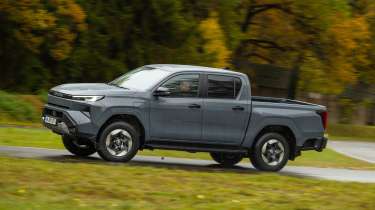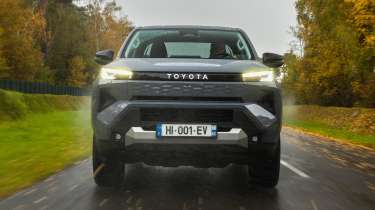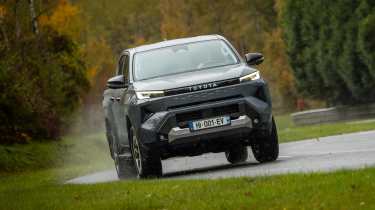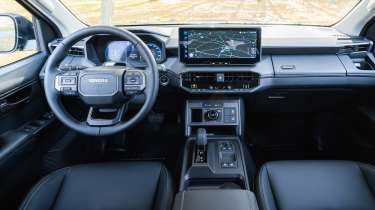Toyota Hilux BEV pick-up review
Toyota’s first electric pick-up is tailor-made for businesses that need go-anywhere ability with zero emissions

Our opinion on the Toyota Hilux BEV
The new Toyota Hilux BEV has been tailored to suit some very specific commercial vehicle requirements, so it doesn’t have the longest range, but put that aside and it’s a pretty impressive package. If you can live with the 150-mile maximum range that its modest battery can deliver, then you’re getting a truck that’s more comfortable and refined on tarmac than its diesel counterpart, while the simplified 4x4 powertrain still delivers more off-road ability than most users are ever likely to need. Payload and towing weights can’t match a diesel Toyota Hilux, but then the users that the BEV is aimed at aren’t likely to need these capacities anyway.
About the Toyota Hilux BEV
With the automotive market moving towards electrification, the concept of the diesel pick-up is increasingly looking like old tech. We’ve seen hybrid and plug-in hybrid trucks launched in the UK, while in the US the likes of the Ford F-150 Lightning and Chevrolet Silverado EV have tried to make inroads into petrol truck sales.
While Toyota takes on Ford and General Motors in the US with its Tacoma and Tundra trucks, it has turned to the European market Hilux for its first foray into all-electric pick-ups. Toyota has also taken the opportunity to give the Hilux an update, with a new look inside and out, plus the latest safety and infotainment tech on board.
Used - available now

2026 Toyota
Corolla
9,500 milesAutomaticPetrol1.8L
Cash £23,421
2021 Vauxhall
Corsa
17,710 milesManualPetrol1.2L
Cash £11,999
2023 Tesla
Model 3
55,000 milesAutomaticElectric
Cash £18,888
2023 Tesla
Model Y Premium
19,000 milesAutomaticElectric
Cash £24,444Under the skin, the Hilux BEV has a re-engineered ladderframe chassis with the drive battery located between the frame rails in an effort to maintain the Hilux’s renowned off-road ability. However, that does mean there has been a compromise in terms of battery size, and the Hilux BEV has a 56.2kWh pack on board.
This is connected to two electric motors – one on each axle – so the Hilux BEV has permanent four-wheel drive. However, thanks to the new electric powertrain, there are no diff locks or low-range gears to deal with. Instead, the new Multi-Terrain System adjusts the response of the electric motors to suit different conditions, either automatically or by selecting one of five preset modes for different surfaces.
Inside, the Hilux BEV features a new interior with digital displays for the driver and centre console, while the dashboard layout has been simplified thanks to the new off-road system.
UK sales of the new Toyota Hilux BEV start in the second quarter of 2026, while prices will be announced closer to time. Expect it to be in the ballpark of its rival electric pick-up, the Isuzu D-MAX Electric.
Range, charging & running costs
Pros |
|
Cons |
|
Prices for the Toyota Hilux BEV have yet to be announced, but you can expect an increase over the diesel model. It’s worth noting that since the electric model doesn’t have a one-tonne payload, it can’t be classified as a commercial vehicle and reap the benefits that this offers. However, since it has zero emissions, Benefit-in-Kind (BiK) costs will be far smaller than they are for the diesel Hilux.
Electric range, battery life and charge time
A gross battery capacity of 59.2kWh for the Hilux BEV is modest when you consider that the KGM Musso EV has an 80.6kWh pack, while the Isuzu D-Max Electric has 66.9kWh of usable capacity. However, Toyota sees the Hilux BEV as a niche commercial vehicle for trades that don’t need to travel long distances, such as forestry work or airport ground services, and it has done thorough research into customer requirements to provide a battery range that’s suitable for such jobs.
At launch, Toyota claims a range of 149 miles from a full charge, which is 86 miles less than the KGM Musso EV can deliver, but the Isuzu D-Max electric isn’t much better than the Toyota, with a combined range of 163 miles.
Our first drive of the Hilux BEV saw a return of around 1.8 miles per kWh on a course featuring plenty of faster sections and acceleration and braking zones, but we will drive the newcomer on UK roads in due course to get a more accurate estimate on potential efficiency.
When the battery needs charging, you can plug into a DC source for a maximum supply of 150kW, according to Toyota. This will take the battery from 10-80 per cent capacity in less than half an hour. If you’re using an AC source, then a wallbox rated at 10kW will fully charge the battery in six-and-a-half hours.
Load space and practicality
Pros |
|
Cons |
|
Locating the drive battery within the chassis rails means that the Hilux BEV doesn’t suffer from any compromises when it comes to the size of its load bed. It measures 1,555mm long and 1,540mm wide with minimal wheelarch intrusion to hamper cargo carrying, while there’s a load bed depth of 480mm, which isn’t quite as good as some rivals, but should be enough for most needs.
The Hilux BEV is only going to be offered as a double cab with no extended or single-cab options planned, although there is talk of a UK-specific commercial version being built to take advantage of HMRC’s tax structure for light commercial vehicles.
The sting in the tail of the electrified Hilux is its reduction in payload and towing weights. While pick-up trucks were always considered heavy, the Hilux BEV weighs in at nearly 2.5 tonnes, which is around 400kg more than the diesel version and on a par with some electric SUVs. But with that weight to carry, there’s less wiggle room for extra weight.
The Hilux BEV has a payload of 715kg, well under the one-tonne requirement for light commercial vehicles in the UK, but that’s more than the KGM Musso EV can carry (500kg), although the Isuzu D-Max Electric does tip over the one tonne mark.
Towing is compromised, too. While the diesel Hilux can haul a maximum of 3.5 tonnes, the BEV is limited to 1,600kg braked. But again, Toyota claims that this is more than enough capacity for the type of users that it’s targeting with the electric model.
Reliability, safety and security
Pros |
|
Cons |
|
Since the Hilux EV has ditched the complex mechanical diff locks and transfer cases of the diesel model, there should be less to go wrong, although that does mean a laptop computer will likely be of more use than a set of tools to fix it when you’re out in the field.
Either way, the Hilux has built a reputation for durability over more than 50 years, and since the BEV is an evolution of the previous truck, there shouldn’t be much to go wrong in terms of the suspension and transmission. The battery is held between the main beams of the ladder chassis with reinforced frame rails and features a bash plate along its entire length, so it’s well protected from any scrapes off road, while the rest of the electric running gear is under the bonnet.
As ever with a double cab pick-up, the interior will be the best place to keep valuables out of sight, unless you specify a load cover or truck top for the cargo bed. Since the BEV model shares its body with the diesel version, there will be a wide range of options available to suit most users’ needs.
Driving and performance
Pros |
|
Cons |
|
Swapping a rattly diesel powertrain for a fully electric one is quite a step change for a pick-up truck. The lack of noise from under the bonnet means that all other sounds are amplified, but since the Hilux BEV is so well built, it does a good job of ferrying passengers in refined silence.
There are three drive modes to choose from – Normal, Eco and Sport – with slight differences between them. Eco mode softens the throttle, although we tend to find that this causes you to press the accelerator harder to overcome the lack of power, while the climate control is limited to help reduce the current drawn from the battery. Sport mode adds a sharper throttle that delivers perkier acceleration, while the steering gains extra weight for a sportier feel.
The silent running of the Hilux BEV adds an eerie quality to off-road driving, as the only sound you often hear is the noise of the tyres crunching over whatever surface you’re negotiating. There is some whine from the electric motors if you need a bit more power to get over a particularly difficult obstacle, but this soon fades away once you’ve negotiated it.
In terms of off-road capability, the BEV matches the diesel Hilux for approach and departure angles (29 and 24 degrees respectively), has the same 700mm wading depth, 207mm ground clearance and 500mm wheel articulation, but the breakover angle is four degrees shallower at 20 degrees.
The electric powertrain offers permanent four-wheel drive, and the response from the system is good from lower speeds. There’s a combined output of 193bhp for the powertrain, while Toyota quotes a torque figure of 206Nm for the front electric motor and 269Nm for the rear. That’s not enough for the Hilux to deliver a rear-biased power delivery, even though it’s available as soon as you pull away, and overall the truck is set up to understeer to keep you out of trouble.
Off the beaten track, the Hilux BEV delivers plenty of ability. There are no diff locks or low-range gears to deal with, because Toyota’s Multi-Terrain Select tailors the electrical system to suit different conditions. There’s an Auto setting that reacts to different surfaces, or you can pre-select Rock, Sand, Mud and Dirt modes to suit the terrain as you approach. Finally, the new Mogul setting is designed to emulate low-range gears. The latter is particularly useful, because it limits power and smooths the transmission out to help keep you moving.
Town driving, visibility and parking
The Hilux is just as big as it’s ever been, so while you have a high vantage point from behind the wheel, this is still a five-metre long truck that needs some space to manoeuvre. Thankfully, there are front and rear parking sensors and a 360-degree camera system on top-spec models to help you negotiate multi-storey car parks or tight wooded lanes.
Toyota has fitted the latest Hilux with electric power steering, and we found that it needs a lot of arm twirling to go from lock to lock, which can be a chore at lower speeds. However, when we tried the truck off-road, it didn’t seem to be as big an issue.
Motorway driving and long-distance comfort
At higher speeds, the Hilux BEV steals a march over its diesel sibling with its refinement and responsiveness. There’s instant power when you press the accelerator, with enough acceleration for the truck to feel brisk, but without the punch in the back you get from some more powerful EVs, and there isn’t the sort of tailing off that can be experienced elsewhere, either.
Once up to speed, the Hilux BEV offers a decent ride. It’s fitted with a de Dion rear suspension set-up, and when combined with the weight of the battery set low in the chassis, this means the truck feels stable and comfortable at higher speeds. The other downside to the lack of diesel drone is present in the form of more wind noise around the door mirrors, although Toyota has added aerodynamic tweaks to help mitigate against this, and it’s only really noticeable when you’re at the motorway limit.
Cab interior and technology
Pros |
|
Cons |
|
Toyota has revamped the Hilux interior to bring it into line with the Land Cruiser, so you get lots of squared-off shapes inside and an upright dashboard. The driving modes are selected via a rotary dial on the centre console, while the off-road settings are activated via the same dial after pressing the Drive Mode button next to it.
The 12.3-inch digital driver’s display contains plenty of info, although it’s not the easiest system to scroll through with the steering wheel controls. There you can set the navigation map or media info, plus there’s a display showing how power is being fed to the front and rear axles.
Infotainment, sat-nav and stereo
There’s another 12.3-inch screen for the main infotainment, and this is set high on the dashboard. It comes with connected services and plenty of functionality, and should be an easy enough system to get along with. Thankfully, Toyota has retained physical controls for the climate system, although the LCD displays look rather old-school when compared with the high-resolution screen set above.
Buying and owning
Alternatives to the Toyota Hilux
The obvious alternative to the Hilux BEV is the Isuzu D-Max Electric. It has a bigger battery and a slightly longer range, while pricing will be similar between the two. Elsewhere, the KGM Musso EV is a left-field choice that has a lighter payload than the Hilux. If you can’t make the jump to a full EV just yet, the Ford Ranger PHEV offers a stop-gap that could deliver the best of both worlds, with the longer range of a diesel combined with lower emissions-based business costs. Toyota also offers a 48-volt hybrid version of the Hilux that will be available in the same bodystyle as the BEV when both models are launched in the second quarter of 2026.
Pick-up dimensions | |||
| Body style | Height | Width | Length |
| Hilux BEV Double Cab | 1,865mm | 1,855mm | 5,320mm |
Load area dimensions | |||
| Body style | Height | Width | Length |
| Hilux BEV Double Cab | 480mm | 1,540mm | 1,555mm |
Frequently Asked Questions
It’s certainly a lot more refined and comfortable than the diesel Hilux on the road, while the power delivery is smooth and its off-road ability is just as good. The crunch point will be the BEV’s range, which Toyota says will be enough for the potential buyers it is targeting (such as Forestry Commission workers, or airside support at airports; basically anywhere that needs a 4x4-capable vehicle that doesn’t cover long distances). Whether it can gain any more sales outside of this niche remains to be seen.







